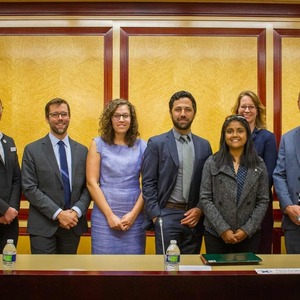Experts discuss wildfire mitigation, beneficial use of biomass




PHOTO: California Council on Science & Technology
September 24, 2019
BY Erin Krueger
The California Council on Science & Technology hosted an expert briefing at the California State Capitol Sept. 19 focused on the beneficial uses of wood biomass from wildfire mitigation. The briefing was the fourth in a series on wildfires hosted by CCST.
The panel featured Kevin Fingerman from Humboldt State University, Angela Lottes from CAL FIRE, Aindrila Mukhopadhyay from the Joint Bioenergy Institute, and George Peridas from Lawrence Livermore National Laboratory. The briefing was moderated by Evan Johnson from the Governor’s Office of Planning & Research. The event was held in partnership with the Office of State Sen. Brian Dahle.
A document released by the CCST in conjunction with the hearing explains that prior to Euro-American settlement, an estimated 4.5 to 12 million acres of forestland burned annually in California. At the turn of the 20th century, the state began to enact policies that aimed to suppress wildfires. A century of fire prevention efforts, however, led to increased densities and fire loads that have resulted in severe, unintended consequences to forest resilience, including the promotion of more destructive wildfires.
Advertisement
Advertisement
Forests treatments, such as thinning, for wildfire mitigation produce large quantities of low-value wood biomass material that is not suitable for traditional lumber. Without an alternative use for this material, it is often burned onsite, which creates no added value and contributes to carbon emissions. Experts, including those featured on the panel, are working to solve that problem through the beneficial use of low-value biomass.
Part of the discussion focused on the challenges of converting low-value forest biomass into energy and products. Fingerman noted the cost of residue mobilization and the current inability to secure long-term sourcing contracts are two of the primary challenges.
He said it can cost $30 to $60 a ton to mobilize that biomass materials from the woods and bring it to a facility where it can be used to produce energy or products. “That’s a significant cost for what is otherwise a very low value product,” Fingerman said.
Advertisement
Advertisement
Companies that want to convert that material into bioproducts, biomaterials or even wood chips also need the ability to secure long-term, consistent supplies of feedstock, he added. The inability to secure that type of contract presents a significant business problem.
Peridas suggested the state government could help solve logistical challenges associated with the use of low-value biomass by transporting biomass to the fence line of facilities that convert the material into fuels, products or energy. If the state determines the use of this biomass material in a priority in terms of fire prevention and climate goals, he also suggested it could provide assistance by making permitting process more efficient.
Additional information, including a video of the briefing, is available on the CCST website.
Related Stories
The U.S. Department of Energy Bioenergy Technologies Office (BETO) announced up to $23 million in funding to support research and development (R&D) of domestic chemicals and fuels from biomass and waste resources.
The U.S. DOE has announced its intent to issue funding to support high-impact research and development (R&D) projects in two priority areas: sustainable propane and renewable chemicals and algal system cultivation and preprocessing.
Sens. Sherrod Brown, D-Ohio, and Pete Ricketts, R-Neb., in August introduced the Renewable Chemicals Act, a bill that aims to create a tax credit to support the production of biobased chemicals.
The Chemical Catalysis for Bioenergy Consortium, a consortium of the U.S. DOE’s Bioenergy Technologies Office, has launched an effort that aims to gather community input on the development of new biomass processing facilities.
USDA on March 8 celebrated the second annual National Biobased Products Day, a celebration to raise public awareness of biobased products, their benefits and their contributions to the U.S. economy and rural communities.
Upcoming Events










